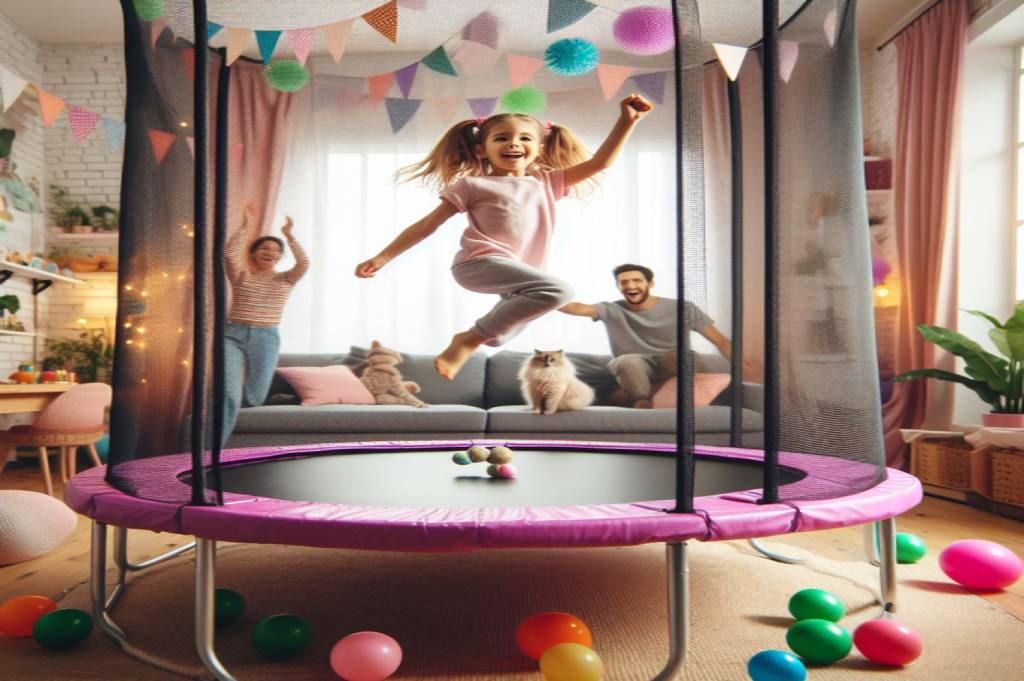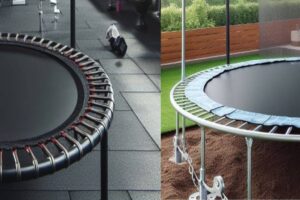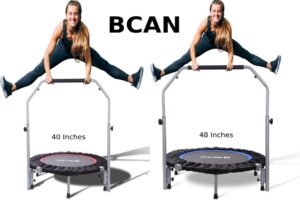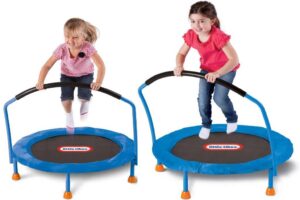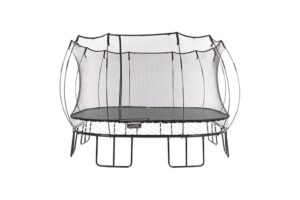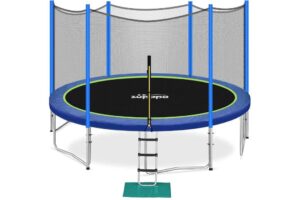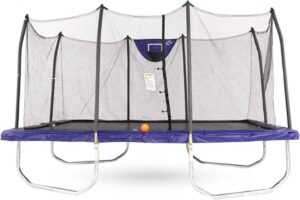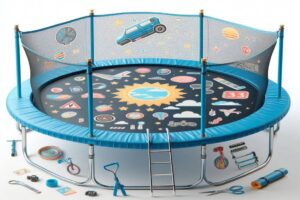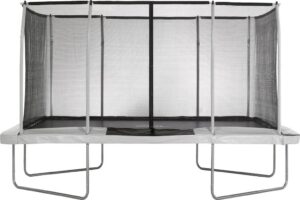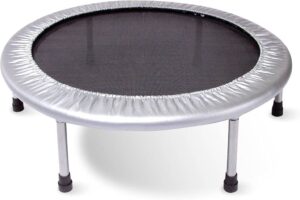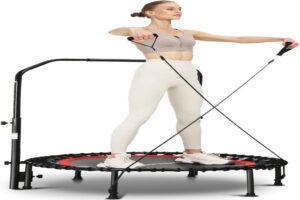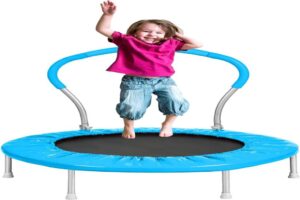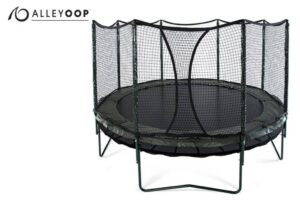Introduction
Indoor vs. Outdoor Trampolines
Welcome to the ultimate showdown between two titans of bouncing: indoor vs. outdoor trampolines. Here, we’ll dive into the heart of the debate, exploring the unique characteristics, advantages, and experiences offered by each type of trampoline. Get ready to dominate your bounce as we unravel the differences and discover which trampoline reigns supreme in your bouncing adventures.
The rivalry between indoor and outdoor trampolines runs deep, each boasting its own set of strengths and advantages. Indoor trampolines carve out their niche as convenient, weather-resistant options that can be enjoyed year-round, rain or shine. Meanwhile, outdoor trampolines harness the vast expanse of the outdoors, offering unparalleled freedom, space, and connection with nature.
Indoor trampolines set the stage for controlled, climate-controlled bouncing experiences. Positioned within the confines of your home or gym, these trampolines provide a safe and convenient space for bouncing enthusiasts of all ages. Whether it’s a compact rebounder for fitness workouts or a larger model for family fun, indoor trampolines offer versatility, accessibility, and comfort.
Outdoor trampolines unleash the thrill of bouncing beneath the open sky, transforming your backyard into a boundless playground of adventure. With ample space to soar, spin, and flip, outdoor trampolines elevate the bouncing experience to new heights. Whether you’re hosting epic bounce parties, practicing gymnastics routines, or simply enjoying the sunshine, outdoor trampolines offer unmatched freedom and excitement.
As we embark on this journey of discovery, it’s essential to consider your preferences, lifestyle, and bouncing aspirations when choosing between indoor and outdoor trampolines. Do you crave the convenience and comfort of indoor bouncing, or are you drawn to the exhilaration and expansiveness of outdoor bouncing? The choice is yours to make, but one thing is certain: whether indoors or outdoors, trampolines promise endless fun, fitness, and adventure for all who dare to bounce.
Remember that the battle between indoor and outdoor trampolines is not about superiority but about finding the perfect match for your bouncing ambitions. Whether you’re dominating your bounce indoors or conquering the skies outdoors, embrace the thrill, excitement, and joy that trampolines bring into your life. Stay tuned as we delve deeper into the world of indoor and outdoor trampolines, uncovering their unique features, benefits, and experiences. Get ready to dominate your bounce and embark on an epic bouncing adventure like never before!
Understanding Indoor Trampolines
Indoor vs. Outdoor Trampolines
Indoor trampolines serve as miniature arenas of excitement and joy, offering a controlled environment for bouncing enthusiasts to indulge in their passion.
Here, we delve into the intricacies of indoor trampolines, exploring their unique features, benefits, and considerations.
Benefits of Indoor Trampolines
Indoor trampolines offer a plethora of benefits, making them a popular choice for individuals and families alike. Firstly, their indoor setting provides a sheltered environment, shielding bouncers from external elements such as adverse weather conditions. This ensures that bouncing sessions can proceed uninterrupted, regardless of rain, snow, or extreme temperatures.
Moreover, indoor trampolines are accessible year-round, making them an excellent option for maintaining an active lifestyle regardless of the season. Whether it’s a chilly winter day or a scorching summer afternoon, indoor trampolines provide a reliable outlet for physical activity and entertainment.
Additionally, indoor trampolines offer versatility in terms of usage. Beyond traditional bouncing, they can be utilized for a variety of activities, including fitness routines, acrobatic training, and imaginative play. This versatility makes indoor trampolines suitable for individuals of all ages and fitness levels, catering to diverse interests and preferences.
Considerations and Limitations of Indoor Trampolines
While indoor trampolines offer numerous advantages, it’s essential to consider certain limitations and factors before incorporating one into your home. Space constraints can pose a significant challenge, as indoor trampolines require adequate room for safe bouncing. It’s crucial to assess the available space within your home and ensure that the trampoline can be installed without compromising safety or obstructing other activities.
Furthermore, safety precautions are paramount when using indoor trampolines, particularly in households with children. Proper supervision and adherence to safety guidelines are essential to prevent accidents and injuries. Additionally, indoor trampolines may generate noise and vibration, which could potentially disturb other occupants of the home. Consideration should be given to minimizing noise levels and ensuring that bouncing activities do not disrupt the peace and tranquility of the household.
Exploring Outdoor Trampolines
Indoor vs. Outdoor Trampolines
Outdoor trampolines beckon adventurers to step outside and immerse themselves in the exhilarating world of bouncing beneath the open sky.
Here, we embark on a journey to explore the unique allure and benefits of outdoor trampolines, from their expansive play space to the sense of freedom they offer.
Advantages of Outdoor Trampolines
Outdoor trampolines boast a myriad of advantages that set them apart as a preferred choice for bouncing enthusiasts. Firstly, they provide an expansive play area, allowing bouncers to soar freely and engage in dynamic exercises without the constraints of indoor spaces. Whether it’s practicing acrobatic flips or simply enjoying the sensation of weightlessness, outdoor trampolines offer ample room for creativity and exploration.
Moreover, outdoor trampolines immerse participants in the beauty of nature, providing a sensory-rich experience that enhances the bouncing adventure. From feeling the warmth of the sun on your skin to listening to the chirping of bird’s overhead, outdoor bouncing stimulates the senses and fosters a deeper connection with the natural world.
Additionally, outdoor trampolines promote physical activity and healthy living by encouraging individuals to spend time outdoors and engage in active play. Bouncing on a trampoline provides a full-body workout that improves cardiovascular health, strengthens muscles, and enhances coordination and balance. With an outdoor trampoline as their playground, individuals of all ages can reap the benefits of exercise while enjoying the fresh air and sunshine.
Challenges and Environmental Factors of Outdoor Trampolines
Despite their many advantages, outdoor trampolines also present certain challenges and considerations that must be addressed. Weather conditions can impact the usability and maintenance of outdoor trampolines, with exposure to rain, snow, and extreme temperatures potentially affecting their durability and performance. It’s essential to implement proper weatherproofing measures and maintenance routines to ensure the longevity of your outdoor trampoline.
Furthermore, safety precautions are crucial when using outdoor trampolines, particularly in households with children. Adequate supervision and adherence to safety guidelines help prevent accidents and injuries, ensuring that bouncing sessions remain fun and risk-free.
Safety Concerns
Indoor vs. Outdoor Trampolines
Trampolines are synonymous with fun and excitement, but it’s essential to recognize the importance of safety when bouncing, whether indoors or outdoors. Here, we delve into the safety concerns associated with both indoor and outdoor trampolines, highlighting key considerations to ensure a safe and enjoyable bouncing experience for all.
Risk Factors in Indoor Bouncing
Indoor trampolines offer the convenience of year-round bouncing within the confines of your home, but they also present unique safety considerations. One of the primary risk factors is the limited space available, which increases the likelihood of collisions with walls, furniture, or other objects. Additionally, the ceiling height must be sufficient to accommodate the height of the bounce, minimizing the risk of head injuries.
Furthermore, the surface surrounding an indoor trampoline may pose hazards, particularly if it’s a hard or slippery material. Falls onto unforgiving surfaces can result in injuries, emphasizing the importance of ensuring a safe landing area around the trampoline.
Safety Measures for Indoor Bouncing
Despite these challenges, there are several safety measures that can be implemented to mitigate the risks associated with indoor trampolines. Firstly, proper supervision is essential, especially for young children who may not fully understand the importance of following safety guidelines. Setting clear rules and boundaries for trampoline use helps ensure that bouncing sessions remain safe and enjoyable for everyone.
Additionally, padding and safety nets can be installed around the trampoline to provide an added layer of protection against falls and collisions. Regular maintenance and inspection of the trampoline and its components are also critical to identify any potential hazards or signs of wear and tear.
Risk Factors in Outdoor Bouncing
Outdoor trampolines offer the allure of bouncing beneath the open sky, but they come with their own set of safety concerns. One of the primary risks is exposure to the elements, including inclement weather conditions such as rain, wind, or extreme heat. Wet or slippery surfaces can increase the risk of slips and falls, while strong winds can destabilize the trampoline and pose a danger to users.
Additionally, the height of outdoor trampolines presents a greater risk of falls from significant heights, highlighting the importance of proper supervision and adherence to safety guidelines.
Safety Measures for Outdoor Bouncing
To mitigate these risks, it’s essential to implement comprehensive safety measures when using outdoor trampolines. Anchoring the trampoline securely to the ground helps prevent it from tipping over or being displaced by strong winds. Installing a safety enclosure around the perimeter of the trampoline provides a barrier to prevent users from falling off the edge.
Regular maintenance and inspection of the trampoline and its components are also essential to ensure that it remains in good working condition and free from potential hazards. Additionally, establishing rules and guidelines for trampoline use and enforcing them consistently helps promote safe bouncing habits and prevent accidents.
Indoor vs. Outdoor Trampolines
| Safety Considerations | Indoor Trampolines | Outdoor Trampolines |
| Risk Factors | 1- Limited space increases collision risks with surrounding objects.
2- Inadequate ceiling height may lead to head injuries if jump height is not appropriately controlled. |
1- Exposure to elements like rain and wind increases slip hazards and destabilization of the trampoline.
2- The height of outdoor trampolines also elevates the risk of falls. |
| Safety Measures | 1- Installation of safety padding and nets around the trampoline helps minimize the impact of falls and reduces the risk of injury.
2- Proper supervision, especially for younger users, is essential to ensure adherence to safety guidelines and prevent accidents. |
1- Anchoring the trampoline securely to the ground prevents it from being displaced by strong winds, ensuring stability and safety.
2- Safety enclosures around the perimeter of the trampoline prevent users from falling off, providing an added layer of protection. |
In conclusion, Both indoor and outdoor trampolines present unique safety considerations. While indoor trampolines demand measures to mitigate collision risks and ensure adequate bounce space, outdoor trampolines require precautions against weather-related hazards and falls from greater heights. By implementing appropriate safety measures, bouncers can enjoy a secure and enjoyable bouncing experience, whether indoors or outdoors.
Maintenance and Durability
Indoor vs. Outdoor Trampolines
Trampolines are not only sources of endless entertainment but also investments in health and family fun. To keep the bouncing experience safe and enjoyable for years to come, proper maintenance and durability are paramount. Here, we delve into the essential aspects of maintaining and ensuring the longevity of your trampoline, whether it’s indoors or outdoors.
Maintenance Tips for Indoor Trampolines
Indoor trampolines may seem sheltered from the elements, but they still require regular maintenance to uphold their safety and performance. Here are some key maintenance tips:
- Cleanliness: Regularly sweep or vacuum the area around the trampoline to remove debris, dust, and pet hair that could compromise the bounce surface or pose slipping hazards.
- Inspect Springs and Frame: Periodically check the springs, frame, and mat for signs of wear, rust, or damage. To avoid accidents, promptly replace any worn or damaged components.
- Padding and Safety Nets: Ensure that the padding and safety nets are securely fastened and free from tears or deterioration. Replace any damaged padding or nets to maintain adequate protection during bouncing sessions.
Weatherproofing and Longevity for Outdoor Trampolines
Outdoor trampolines face exposure to the elements, making weatherproofing and durability crucial factors in maintenance. Consider the following tips:
- Weather-Resistant Materials: Invest in a high-quality trampoline made from weather-resistant materials such as galvanized steel frames and UV-resistant jump mats. These materials withstand outdoor elements and prevent premature deterioration.
- Regular Inspections: Conduct regular inspections of the trampoline’s components, including springs, frame, and safety enclosure. Look for signs of rust, corrosion, or wear, and address any issues promptly to prolong the trampoline’s lifespan.
- Covering: During inclement weather or extended periods of non-use, cover the trampoline with a weatherproof cover to protect it from rain, snow, and UV exposure. This simple measure prevents damage and extends the life of your outdoor trampoline.
Indoor vs. Outdoor Trampolines
| Aspect | Indoor Trampolines | Outdoor Trampolines |
| Weather Exposure | Sheltered from outdoor elements, reducing wear and tear | Exposed to weather conditions such as sun, rain, and wind |
| Maintenance Frequency | Generally lower maintenance due to indoor environment | Higher maintenance required to combat outdoor elements |
| Cleaning Requirements | Minimal cleaning needed; dust and debris accumulation may occur | Regular cleaning necessary to remove dirt, leaves, and debris |
| Material Durability | Typically constructed with lightweight materials suitable for indoor use | Built with weather-resistant materials like galvanized steel and UV-resistant fabric |
| Risk of Rust | Lower risk of rust due to indoor environment | Higher risk of rust, especially in humid or coastal areas |
| Replacement Parts | Parts may need replacement over time due to wear and tear | Components such as springs, mats, and frames may require more frequent replacement |
| Overall Lifespan | Generally longer lifespan due to reduced exposure to elements | Lifespan may vary depending on quality of materials and maintenance efforts |
In conclusion, proper maintenance and durability measures are essential for preserving the safety and longevity of your trampoline, whether it’s situated indoors or outdoors. By following the maintenance tips outlined above and investing in high-quality materials and components, you can ensure that your trampoline remains a reliable source of fun and exercise for your family for years to come.
Space and Location Considerations
Indoor vs. Outdoor Trampolines
When it comes to setting up your trampoline, choosing the right space and location is crucial for safety, enjoyment, and longevity. Here, we’ll explore the various considerations involved in determining the optimal placement for your trampoline, whether it’s indoors or outdoors.
Indoor Trampolines: Maximizing Space Efficiency
Indoor trampolines offer the convenience of year-round bouncing without being at the mercy of weather conditions. However, selecting the right space within your home is essential to ensure safety and functionality. There are some considerations you will take in mind
- Ceiling Height: Measure the height of your ceilings to ensure they provide adequate clearance for jumping. Ideally, there should be at least several feet of space between the trampoline and the ceiling to accommodate higher jumps and prevent collisions.
- Flooring: Choose a location with a suitable flooring surface, preferably a level and resilient material such as hardwood, laminate, or carpet. Avoid placing the trampoline on hard surfaces like concrete or tile, as these can increase the risk of injury in case of falls.
- Space Considerations: Ensure there is sufficient clearance around the trampoline to allow for safe entry and exit. Remove any furniture or obstacles that may impede movement or pose collision hazards. Additionally, consider the noise level generated by bouncing and choose a location that minimizes disturbance to other occupants of the home.
Outdoor Trampolines: Harnessing the Great Outdoors
Outdoor trampolines offer the freedom of bouncing beneath the open sky, but proper placement is essential to maximize safety and enjoyment.
- Yard Size and Terrain: Select a spacious and level area of your yard for the trampoline, free from obstructions such as trees, branches, or overhead wires. Ensure the ground is firm and even to provide a stable foundation for the trampoline.
- Sun Exposure: Consider the orientation of the trampoline concerning the sun’s path throughout the day. Optimal placement should provide a balance of sun and shade to prevent excessive heat exposure during peak hours.
- Wind Exposure: Position the trampoline away from areas prone to strong winds or gusts. While a gentle breeze can enhance the bouncing experience, windy conditions can destabilize the trampoline and increase the risk of accidents.
Indoor vs. Outdoor Trampolines
| Aspect | Indoor Trampolines | Outdoor Trampolines |
| Available Space | Limited by indoor area, suitable for smaller trampolines | Offers larger area options, depending on yard size |
| Ceiling Height Requirement | Requires sufficient ceiling height for safe bouncing | No height restrictions, but consider clearance from trees |
| Flooring Considerations | Can be placed on various indoor surfaces (e.g., carpet, hardwood) | Requires flat, level ground free of obstacles |
| Weather Dependence | Unaffected by weather conditions, can be used year-round | Subject to weather conditions (e.g., rain, wind, sunlight) |
| Noise Concerns | Potential noise disturbance indoors, depending on flooring | Noise less of a concern outdoors, except in close neighborhoods |
| Accessibility | Easy access for regular use within the home | May require walking outside to reach the trampoline |
In conclusion, when considering space and location for your trampoline, it’s important to weigh the pros and cons of indoor and outdoor options. Indoor trampolines offer convenience and accessibility but are limited by space and ceiling height. Outdoor trampolines provide ample room for bouncing and aren’t affected by weather but require suitable outdoor space and may pose noise concerns in close neighborhoods. Ultimately, the decision depends on your available space, preferences, and lifestyle.
Cost Comparison
Indoor vs. Outdoor Trampolines
Investing in a trampoline brings boundless joy and entertainment for the whole family, but it’s essential to consider the financial aspects before buying decision. Here, we’ll conduct a comprehensive cost comparison between indoor and outdoor trampolines to help you make an informed choice based on your budget and preferences.
-
Indoor Trampolines
The initial cost of indoor trampolines tends to be lower compared to outdoor models. Basic indoor trampolines, designed for home use, are often more affordable due to their smaller size and simpler construction.
However, additional expenses may arise for indoor trampolines, such as installation fees if professional assistance is required, or the purchase of accessories like padding and safety nets for enhanced safety.
-
Outdoor Trampolines
Outdoor trampolines typically entail a higher initial investment due to their larger size, sturdier construction, and weather-resistant materials. The cost varies depending on factors such as size, brand, and features.
In addition to the trampoline itself, outdoor setups may require accessories like anchoring kits, weatherproof covers, and maintenance tools, which can add to the overall cost.
Long-Term Expenses and Value
-
Indoor Trampolines
Indoor trampolines generally have lower long-term maintenance costs compared to outdoor models since they are sheltered from the elements and experience less wear and tear.
However, ongoing expenses may include electricity costs for indoor lighting and heating, as well as occasional replacement of parts due to normal wear and tear.
-
Outdoor Trampolines
While outdoor trampolines require more significant upfront investment, they offer excellent value over time with proper maintenance. High-quality outdoor models are built to withstand weather conditions and last for many years.
Long-term expenses may include periodic maintenance, such as replacing worn-out springs or mats, as well as investing in accessories like weatherproof covers to prolong the trampoline’s lifespan.
Indoor vs. Outdoor Trampolines
| Aspect | Indoor Trampolines | Outdoor Trampolines |
| Initial Cost | Generally lower due to smaller size and simpler construction | Higher due to larger size and more robust materials |
| Additional Expenses | Minimal, may include installation or accessories | More significant, may include installation, accessories, and maintenance |
| Long-Term Expenses | Lower maintenance costs due to sheltered environment | Higher maintenance costs due to exposure to weather elements |
| Utility Costs | May increase energy costs for indoor heating and lighting | No additional utility costs, but may require occasional cleaning or maintenance |
| Accessories | Optional accessories available, such as padding and safety nets | Additional accessories like weather covers and anchor kits may be necessary |
| Overall Value | Lower initial investment with potential for long-term savings | Higher initial investment with potential for increased durability and lifespan |
When comparing costs between indoor and outdoor trampolines, it’s important to consider both upfront expenses and long-term maintenance. While indoor trampolines may offer lower initial costs and utility expenses, outdoor trampolines provide greater durability and may require fewer replacements over time. Ultimately, the decision depends on your budget, space availability, and preferences regarding usage and maintenance.
Customization and Features
Indoor vs. Outdoor Trampolines
Trampolines have evolved beyond mere bouncing platforms; they’re now customizable entertainment hubs that cater to individual preferences and needs. Here, we’ll delve into the exciting world of trampoline customization and the diverse features available to enhance your bouncing experience, whether indoors or outdoors.
Personalizing Your Trampoline: Indoor vs. Outdoor Trampolines
-
Indoor Trampolines
Indoor trampolines offer a plethora of customization options to suit various preferences and space constraints. From compact mini-trampolines designed for fitness enthusiasts to larger models equipped with interactive features for family fun, the possibilities are endless.
Consider features such as adjustable height settings, foldable frames for easy storage, and detachable safety handles for added stability during workouts. Some indoor trampolines even come with built-in sound systems or LED lights to elevate the bouncing experience.
-
Outdoor Trampolines
Outdoor trampolines also offer a wide range of customization options, allowing you to create your ultimate backyard oasis. Choose from various sizes, shapes, and designs to complement your outdoor space and meet your family’s needs.
Explore features like safety enclosures, ladder attachments for easy access, and anchor kits to secure the trampoline to the ground. You can also customize the appearance of your outdoor trampoline with colorful padding, weatherproof covers, or personalized decals.
Specialized Features for Enhanced Enjoyment
-
Interactive Games and Accessories
Many trampolines come with optional accessories and add-ons to enhance the bouncing experience. Consider investing in accessories such as basketball hoops, volleyball nets, or foam pits to add a new dimension of fun to your trampoline sessions.
Interactive games like trampoline dodge-ball or tag can turn your backyard into a lively playground for family and friends. Look for trampolines equipped with game kits or compatible accessories to create an exciting entertainment hub for all ages.
-
Safety and Convenience Features
Safety should always be a top priority when customizing your trampoline. Look for features like reinforced frames, high-quality padding, and sturdy safety enclosures to ensure a safe and secure bouncing environment.
Additionally, consider convenience features such as weatherproof covers, storage compartments for accessories, and easy-to-follow assembly instructions to streamline maintenance and setup processes.
User Experience and Preferences
Indoor vs. Outdoor Trampolines
Trampolines are more than just pieces of equipment; they’re gateways to exhilarating experiences and boundless fun. Here, we’ll explore the diverse user experiences and preferences that shape the world of trampolining, helping you find the perfect fit for your bouncing adventures, whether indoors or outdoors.
-
Indoor Trampolines
Indoor trampolines offer a controlled environment for bouncing, shielding users from external elements like weather and temperature fluctuations. This controlled setting provides a consistent experience, making indoor trampolines ideal for year-round use and spontaneous bouncing sessions.
Users often appreciate the convenience and accessibility of indoor trampolines, which can be set up in any room with sufficient space. Whether it’s a dedicated home gym or a corner of the living room, indoor trampolines fit seamlessly into various lifestyles and preferences.
-
Outdoor Trampolines
Outdoor trampolines immerse users in the beauty of nature, providing a sensory-rich experience that enhances the bouncing adventure. Bouncing beneath the open sky offers a sense of freedom and connection with the outdoors, making outdoor trampolines a popular choice for families and outdoor enthusiasts.
While outdoor trampolines may be subject to weather conditions, users often embrace the elements as part of the bouncing experience. From feeling the warmth of the sun to enjoying the cool breeze, outdoor bouncing offers a dynamic and refreshing experience that appeals to many.
User Preferences: Tailoring the Bounce to Your Needs
-
Fitness Enthusiasts
For fitness-focused users, trampolines offer a fun and effective way to stay active and burn calories. Indoor trampolines equipped with adjustable tension settings and workout programs cater to users looking for a low-impact cardio workout in the comfort of their home.
Outdoor trampolines provide a spacious and dynamic environment for fitness enthusiasts to engage in high-intensity workouts, plyometric exercises, or group fitness classes. The larger surface area and freedom of movement make outdoor bouncing an exhilarating and effective fitness option.
-
Families and Children
Families and children often prioritize safety, durability, and entertainment value when choosing a trampoline. Indoor trampolines with safety enclosures and padded frames provide peace of mind for parents, while interactive features like sound systems or LED lights enhance the entertainment factor for kids.
Outdoor trampolines offer a versatile and inclusive space for family fun and bonding. Features like safety enclosures, ladder attachments, and customizable accessories ensure a safe and enjoyable bouncing experience for users of all ages.
Conclusion
Indoor vs. Outdoor Trampolines
As we conclude our exploration into the world of trampolines “Indoor vs. Outdoor Trampolines” , it’s time to reflect on the excitement, fun, and adventure they bring into our lives. From indoor setups to outdoor oases, trampolines have captured our imaginations and provided endless opportunities for enjoyment and fitness. In this final section, let’s recap our journey and celebrate the joy of bouncing.
We’ve delved into various aspects of trampolines, from their unique features and customization options to the safety considerations and user experiences that shape our bouncing adventures. We’ve explored the benefits of indoor and outdoor trampolines, compared costs and maintenance requirements, and discussed the diverse preferences and needs of trampoline users.
At the heart of it all, trampolines represent more than just pieces of equipment; they’re portals to joy, excitement, and connection. Whether you’re bouncing solo to unwind after a long day, engaging in lively games with family and friends, or using the trampoline as a tool for fitness and exercise, the experience is nothing short of exhilarating.
As we bid farewell, let’s carry the spirit of bouncing with us into the future. Let’s continue to embrace the joy of bouncing, whether it’s in our living rooms, backyards, or local trampoline parks. Let’s prioritize safety, fun, and fitness in our bouncing adventures and create lasting memories with loved ones along the way.
In conclusion, the journey of exploring trampolines has been filled with excitement, discovery, and inspiration. As we close this chapter, let’s remember that the joy of bouncing knows no bounds. Whether you’re a seasoned enthusiast or new to the world of trampolines, there’s always something new to discover and experience. So, let’s keep bouncing into tomorrow with enthusiasm, curiosity, and a sense of adventure. Here’s to many more moments of laughter, exhilaration, and boundless fun on the trampoline!
Related posts:
- Trampoline Safety Tips – Jumping for Joy without the Risk
- Trampoline Assembly Excellence: Your Comprehensive Step-by-Step Guide to Bouncing Bliss!
- Trampoline Hole Repair Guide: Masterful Fixes for Unleashing Bouncing Power!
- The Ultimate Trampoline Measurements Guide: Elevate Your Bouncing Experience
- Rebounding for Cardio Fitness: Unlock Heart Health Power

